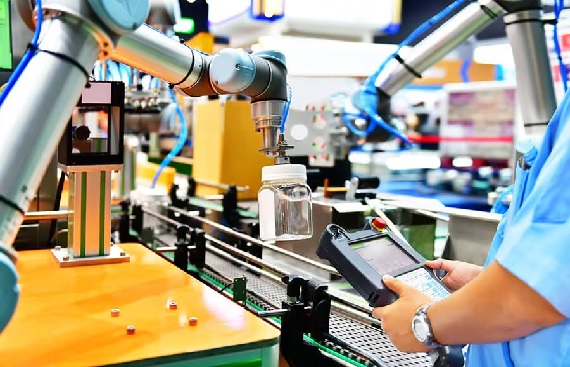How Robotics Empowers Industries for Efficiency and Innovation

Robotics in industries marks a historic turn in the path to empowerment, leading to an era of automation and efficiency that expands traditional operational paradigms. Industrial robots, equipped with cutting-edge sensors, precision-driven actuators, and intricate control systems, have become indispensable assets across sectors such as manufacturing and production. Their prowess extends from setting up meticulous welds and streamlining assembly lines to revolutionizing logistics and healthcare processes with unparalleled accuracy. The automotive industry, for instance, leverages robotic automation to fine-tune assembly lines, ensuring unchanging product quality and heightened productivity. Meanwhile, logistics warehouses have undergone a metamorphosis, entrusting robots with inventory management and order fulfillment, expediting operations on an unprecedented scale. While challenges of cost, safety, and integration persist, the realm of robotics is propelled by continuous innovation. The convergence of artificial intelligence and the advent of collaborative robots, or "cobots," further magnify their capabilities, facilitating a symbiotic relationship between human ingenuity and mechanical precision. As industries strive for amplified efficiency and reduced labor costs, the role of robotics is poised to expand significantly, recalibrating the landscape of work and manufacturing. This article embarks on an illuminating journey to unravel the profound impact of robotics on industry empowerment, illuminating how these innovative trends are revolutionizing operational methodologies and steering industries toward a future shaped by the fusion of human intellect and technological advancement.
The Historical Odyssey
The concept of robotics traces its origins to ancient myths and legends, where tales of mechanical beings hinted at a future yet to be realized. However, the true dawn of modern robotics began to emerge in the early 20th century. The word "robot" was first used by Karel Capek in 1920 in his play "Rossum's Universal Robots," which introduced artificial beings made to help people. After World War II, a new era began when technological developments made industrial robots possible. In 1954, George Devol and Joseph Engelberger unveiled the first programmable robotic arm, the Unimate, which revolutionized manufacturing on General Motors' assembly lines. This momentous event marked the birth of industrial automation and laid the groundwork for the robotics revolution across sectors.
The Evolution Unveiled
The latter half of the 20th century witnessed the metamorphosis of robotics from mechanical manipulators to advanced systems capable of intricate tasks. Early industrial robots precisely executed repetitive tasks, enhancing productivity and quality on factory floors. These robots, often confined within protective enclosures, became synonymous with industry automation. The arrival of microprocessors and computing technology in the 1970s marked a pivotal turning point. Sensors, actuators, and programmable logic controllers infuse robotics with adaptability, enabling machines to navigate changing environments and collaborate with humans. The era of collaborative robots, or "cobots," dawned, allowing devices to work with humans, synergizing human innovation with robotic efficiency.
The Digital Epoch: Robotics Today
The 21st century has propelled robotics into uncharted territory, spurred by advances in artificial intelligence, machine learning, and sensor capabilities. This fusion has propelled robotics beyond mere automation, ushering in an era of intelligent machines capable of learning, adapting, and making informed decisions. Today, robotics pervades diverse industries, from manufacturing and healthcare to agriculture and logistics. Robots have transcended assembly lines, performing intricate surgeries, navigating complex environments, and even exploring the cosmos. The convergence of robotics and AI has bestowed robots with natural language processing, image recognition, and predictive analytics, facilitating seamless human-machine interactions and optimizing operations with unprecedented precision.
Empowering Industries
Integrating robotics into industries marks a seismic shift in the path to empowerment. As the lines blur between human and machine capabilities, enterprises are experiencing newfound efficiency and innovation. Armed with advanced sensors and AI algorithms, robots tackle tasks with unparalleled precision, minimizing errors and optimizing processes. The accuracy and consistency of robotic systems have revolutionized industries such as manufacturing. Robots perform intricate tasks in automotive assembly, ensuring uniform quality and reducing production time. Robots navigate vast warehouses in logistics, enhancing inventory management and order fulfillment speed. Robotics empowers industries to explore realms of innovation previously deemed inaccessible. The partnership between humans and robots sparks creativity as machines handle mundane tasks, liberating human minds to engage in complex problem-solving and imagination. In healthcare, robots assist surgeons with precision, reducing invasiveness and improving patient outcomes.
While the integration of robotics promises an empowered future, it also presents challenges that demand attention. The initial costs of implementing robotic systems can be prohibitive, requiring careful evaluation of return on investment. Safety concerns require innovative solutions to ensure seamless human-robot collaboration, especially in dynamic environments. The ethical implications of job displacement due to automation must be addressed. Industries are tasked with nurturing a workforce that seamlessly integrates with robotic systems, upskilling and reskilling employees to embrace the new opportunities emerging from automation.
As for the result, the development of robotics in industry describes a journey from the simple to the extraordinary. From Unimate's invention on auto assembly lines to modern intelligent robots navigating complex medical procedures, robotics has wholly changed a variety of industries around the world. Empowerment is at the forefront as industries navigate the delicate balance between human potential and technological prowess. Robotics amplifies human ingenuity, augments efficiency, and empowers industries to embark on innovative ventures previously inconceivable. The evolution continues as robotics converges with technologies like 5G, IoT, and quantum computing. These developments promise a future where industries flourish, are adaptive and are empowered in a landscape defined by the harmonious coexistence of human creativity and robotic precision. The tale of robotics in the industry is a testament to human ambition, technological progress, and the boundless possibilities that emerge at the intersection of innovation and empowerment.
